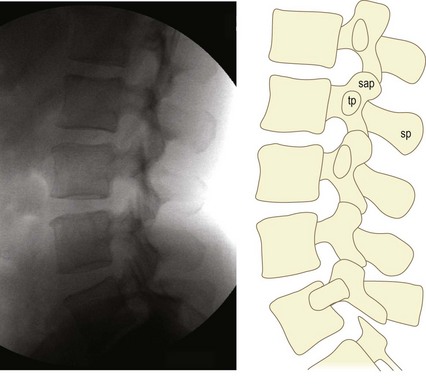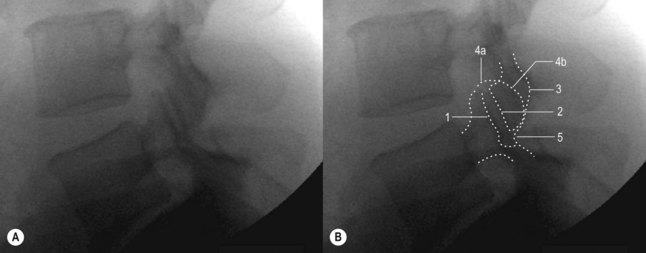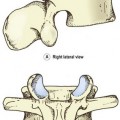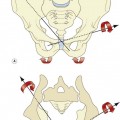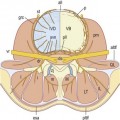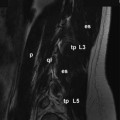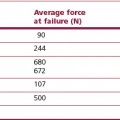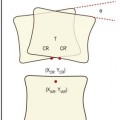Chapter 18 Radiographic anatomy
Lateral views of the lumbar spine are relatively simple; few parts are superimposed, but anteroposterior (AP) views are complicated by multiple parts being superimposed. Under those conditions, interpretation is assisted by the use of anatomy by expectation (see Ch. 17). The reader should expect what should be present, and then determine if what they expect is, indeed, evident on the image.
Lateral views
When viewing a lateral radiograph of the lumbar spine (Fig. 18.1), the reader should expect to see the osseous anatomy evident in a lateral view of an anatomical specimen (as described in Ch. 17) (Fig. 18.2). Soft tissues, such as the ligamentum flavum and spinal nerves will not be evident, but the vertebral bodies and posterior elements will be evident. The intervertebral discs will not be evident; they will appear as spaces between the vertebral bodies.
On the radiograph, select a vertebra image that is the least obscure: typically that of L3. The superior, anterior and inferior margins of the vertebral body should be evident, as they are not obscured by any overlying shadows. Trace those margins (Fig. 18.3). Continue the tracing onto the posterior margin until that margin meets the root of the pedicle. Continue the tracing onto the pedicle. Thereafter, the tracing may become difficult, but the reader is helped by looking for what they expect to see. Based on what they know to be the anatomy of the superior articular process (Fig. 18.2), the reader should expect that, from the posterior superior corner of the pedicle, the superior articular process would project dorsally and cephalad, like the rounded head of a small mushroom. Therefore, regardless of any other lines that might be evident, the reader should look to see if any lines correspond with such a rounded projection. From the superior border of the pedicle, the tracing should continue to circumscribe this rounded projection (Fig. 18.3).
Similarly, the reader should expect that, from the posterior inferior corner of the pedicle, a narrow lamina would project caudally and slightly dorsally, and eventually expand into a rounded mass that is the inferior articular process. As before, other lines should be disregarded, and only those that conform to this expectation should be traced to complete the inferior articular process (Fig. 18.3).
The reader should expect that the transverse process projects as an elliptical shadow at the junction between the pedicle and the superior articular process. Finding such an elliptical shadow locates the transverse process (Fig. 18.3).
For the spinous process, the reader should expect a projection, with the profile of the blade of an axe, arising from the back of the lamina. Finding and tracing the margin of the spinous process completes the identification of the posterior elements (Fig. 18.3).
Having accomplished this tracing of the L3 vertebra, the reader can repeat the process for all other vertebrae, until all lumbar vertebrae have been traced (Fig. 18.4). In this process, two details arise. Firstly, unlike those of typical lumbar levels, the transverse process of L5 has a large base that flows onto the pedicle and vertebral body of L5. Secondly, at all segmental levels, the superior articular processes cover the inferior articular processes of the vertebra above. The latter introduces a complexity.
Because bones behave as if they are transparent under X-ray, multiple markings can appear in the zygapophysial joints. These markings may create the illusion that the joint space projects laterally (Fig. 18.5). This appearance arises when C-shaped or J-shaped joints are viewed from the side. What appear to be the joint margins in a radiograph (lines 1 and 2 in Fig. 18.5) are only the articular margins of the ventral portion of the joint (Fig. 18.6A); but this is not the entire joint. The inferior articular process also presents the remainder of its joint surface laterally (Fig. 18.6B). This surface will be covered laterally by the remainder of the superior articular process (Fig. 18.6C), and in an intact anatomical specimen the inferior articular process will no longer be visible (Fig. 18.6D). As a result of this arrangement, line 2 in Figure 18.5B is continuous with the rest of the inferior articular process (line 3); and lines 4a and 4b form the outer margin of the superior articular process, which becomes continuous with the lamina as line 5. Having identified the silhouettes of all the parts of the lumbar vertebrae, the reader should then be able to imagine the location of related structures that are not visible with X-rays.
